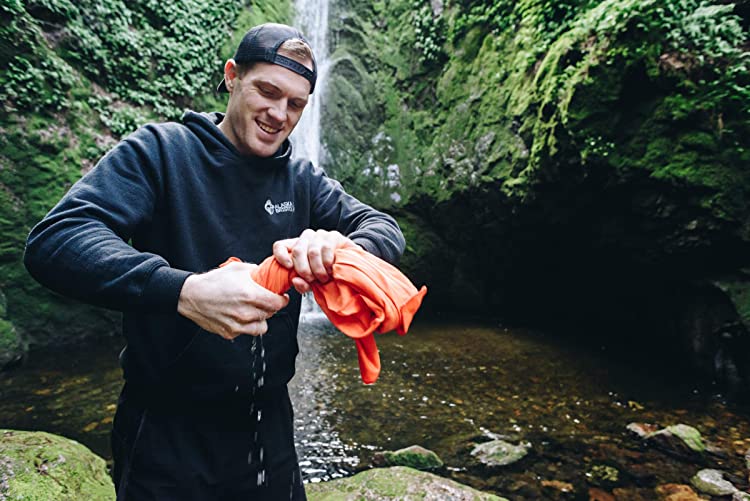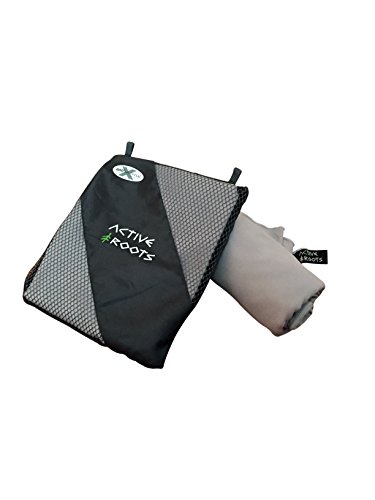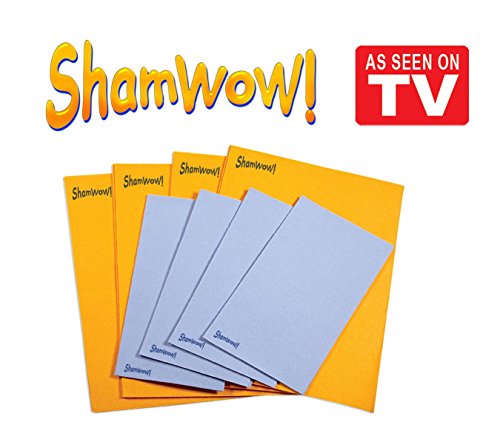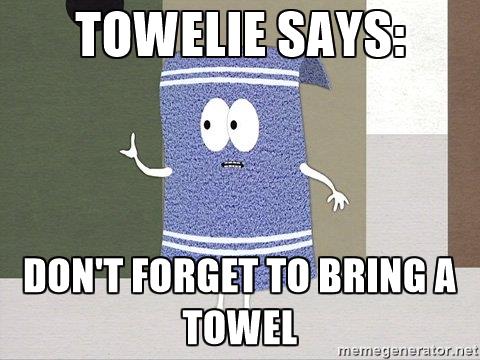
The way I smell after hiking, even after a single weekend, is horrendous.
Now, you might be thinking: ‘wow, this guy is gross. When I go camping I never smell.’
**News flash**
You probably smell worse than me.
More...
Come on, admit it: it’s hard to stay clean in the great outdoors. Washing up in a river or a lake is always colder than it should be. But skipping a wash is not only a smelly habit but a dangerous one. The best way to prevent Lyme disease is to stop ticks from biting and a good dip underwater will make those little buggers fall off.
Drying off after a chilly wash will raise your core temperature quickly and make the process of staying clean that much more comfortable. Having a backpacking towel is also great for keeping the sun off your face, wiping condensation from inside a tent, and of course, is the ultimate mosquito/fly killing device.
Long story short: don’t forget to bring a towel.
First, let’s look at a quick summary of the best backpacking and camping towels on the market today.
Comparison Chart
Name | Price | Weight | Rating | Notes |
|---|---|---|---|---|
$$$ | 8.1 oz | A portion of each microfiber towel sale is donated to the Elephant Conservation Center in Laos | ||
$$$ | 13.8 oz | 8 piece set. Holds 21 times its weight in liquid | ||
$$$ | 9.6 oz | 78% Smaller than the average towel when folded down | ||
$$$ | 8.5 oz | Very Lightweight compared to cotton towels but still Absorbs 3 times its Weight | ||
$$$ | 4 oz | Feather light towel, Dries Quickly. | ||
$$$ | 3.2 oz | Comes with an oval-shaped zippered mesh pouch | ||
$$$ | 6.1 oz | Ultra Soft Compact Quick Dry Microfiber Best Fast Drying Fitness Beach Hiking Yoga Travel Sports Backpacking | ||
$$$ | 13 oz | Machine washable for easy care; the microfiber fabric dries quickly so you can repack the towel soon after you use it | ||
$$$ | 8 oz | can hold up to five times its weight in water, making it the most functional microfiber towel for travel packing. | ||
$$$ | 5.6 oz | The ideal quick dry towel for travel. Dries 3 times faster than a normal cotton towel! A COMPACT beach towel, includes travel accessory pouch. |
Here’s what to look for in a backpacking or camping towel
ABSORBENT
Carrying a towel would be pretty stupid if it was terrible at absorbing liquids. Do your research and be sure to invest in one made from the correct material (we’ll get into what those materials are below).
Quick drying
Packing a wet towel in your backpack is a terrible decision. Not only will the towel never dry but all your other gear will get wet and start to smell. Pick a towel made from material that can dry quickly; many of the new fiber materials on the market are excellent choices.
Lightweight
Some would argue this is the most important aspect to every backpacking towel: its weight and size. If your towel cannot fit in your pack, it’s worthless in the backcountry. This is an important note because traditionally, towels are used as makeshift clothing and can be quite large. Your camping towel does not need to be worn, it only needs to dry you off.
It’s all about the materials
How well your towel works really comes down to what it’s made of.
Different materials bring different levels of absorbency, weight and durability. Ultimately, there are five types of towel material.
Microfiber
This is the most popular material for backpacking and camping towels. And for good reason: microfibre is an ingenious product (the science behind it is interesting) that can actually hold seven times its weight in water. Plus it’s fairly lightweight, dries super-fast and is quite soft.
Cotton
Boo! Boo Cotton! This isn’t the best material for a backpacking towel because it takes eons to dry. Sure, cotton feels wonderful and absorbs a lot of liquid, but it’s not particularly light. My suggestion: avoid most cotton towels if you’re on any kind of an overnight pack trip.
Bamboo
This is a nice eco-friendly material that also absorbs liquid quite well. In fact, it’s been reported that bamboo is up to 40% more absorbent than cotton. But bamboo isn’t quite as strong as cotton, so your towel may not survive as many washes.
Synthetic
There are a lot of new-technology fabrics on the market as well. For example, Discovery Trekking’s towel (see below) uses Polygiene that apparently lasts longer and inhibits the growth of bacteria. There are far too many ‘synthetic’ towel fabrics out there to list in this spot.
Here at S&TT we want to help you stay clean, dry, and healthy. Below are 5 of the best towels for backpacking that spread the gamut of outdoor uses. And either one will make an excellent addition to your pack..
Best Camping & Backpacking Towels (2020)
This towel was created by a new gear company called Active Roots, which aims to “design the highest quality backpacking adventure gear at a broke backpacker-friendly price.”
Their microfiber towel delivers on that promise. This towel is highly absorbent and doesn’t stink after regular use, unlike a lot of other products. The real beauty of this little number is how small it folds down, so it won’t take up too much extra space in your pack.
It’s a great multi-purpose tool as well: the XL size is big enough that it can double as a blanket or a pillow. And weighs only a few ounces.
Overall, this a solid backpacking towel. But the kicker is that Active Roots donates a portion of each towel sale to the Elephant Conservation Center in Laos, which is dedicating to protecting and rehabilitating the endangered elephant population in Asia.
Lots of good reasons to try this towel on your next trek.
Not marketed as a backpacking towel, the Shamwow is actually an amazing little square of fabric. Super absorbent and fairly quick to dry, I was surprised at how awesome it worked for me. It dries extremely efficiently, absorbing water just as advertised. I really liked how good it performed cleaning condensation from my tent; having a wet rainfly in the morning is never a fun experience.
It is not as flexible as the other towels listed and not as soft on the skin, but the price point is unbeatable. At 15 inches by 15 inches the shamwow is easy to trim and customize. This pack actually comes with three, giving you an extra pair in case something happens to your first towel. My only gripe with this product is its bulkiness, it is not as easy to roll up and pack tight like some of the actual pack towels on the market.
Still, at the low price, the Shamwow is a decent budget option.
I like this towel because it rivals the larger cotton towels found in bathrooms. It is big (36×60 inches) but because of the lightweight microfiber material, it packs down extremely well. This is a great towel for lounging lakeside and having a more comfortable experience. More for people at the opposite end of the ultralighting spectrum but if carrying a larger towel means a better hike, then the Waves Gear Microfiber Beach Towelis the correct purchase to make.
Raqpak is the culmination of backpacking technology merging with fitness gear. It is lightweight, made with the microfiber material we have all grown to love (or tolerate), yet it is large enough to be used in more settings other than camping. At 40×20 inches, it is the smallest size available: ample for covering the head and shoulders, but small enough to pack for a weekend trek. Treated with antibacterial agents to prevent mold, the Raqpack Microfiber Travel Towel towel will survive those inevitable wet packing days and not smell as bad as towels that were maybe not treated.
The microfiber material means drying off is more of a dabbing motion than a scrubbing motion. Some people, especially with longer hair, complain this new age material does not dry hair quite as well as the more traditional cotton towels.
The new kid on the block, this towel was invented because of the backlash to microfiber.
The material is soft and almost fluffy, allowing the user to dry as they would with a cotton towel. Its antibacterial properties allow it to stay smell free and softer long after other pack towels would. Folding up to the size of a smartphone with a total size of 34×58 inches, this towel is every bit as versatile as the competition. For the hardcore minimalist, the Discovery Trekking Outfitters High Tech Towel can very easily replace the bathroom one. These will run ya $14 to $60 on Amazon.
The Tek Towel is Sea to Summit’s take on a microfiber towel with their own unique twist. The material of this towel is purely synthetic – a combination of polyester and nylon. It is also a little thicker than most other microfiber towels.
The result is a lightweight towel that they claim has a “plush terrycloth” feel.
Indeed, this towel is more comfortable than the usual microfiber towels without packing on a lot of added weight and bulk. If you’re the type who just cannot get used to the feel of microfiber towels, then you might want to give the Tek Towel a shot.
Because of the use of purely synthetic materials, the Tek Towel dries very quickly. It also comes with a molded plastic pouch with a zipper enclosure which is a much more stylish way of storing it, although the semi-hard plastic may not be as useful for backpackers.
Although the Tek Towel is still a lot lighter and thinner than a standard cotton towel, it does pack a bit of extra bulk for sake of added comfort. When folded up, the XL version of the towel measures around 10 inches across. For those who like packing very light, the Tek Towel may be a little too heavy and bulky.
Family-run Wise Owl Outfitters has developed a microfiber towel that is much softer and more comfortable than most other microfiber towels out there. This towel is so comfortable that it has been compared to suede. According to them, the Ultra Soft Camping Towel can absorb eight times its weight in water, which makes it one of the most absorbent microfiber towels available today. Despite the fuzzy finish, the Ultra Soft Camping Towel still dries pretty quickly – it takes just ten minutes to dry the towel in direct sunlight.
The towel comes with a mesh carry bag and a bonus washcloth, which is perfect for wiping down the condensation inside your tent or any excess dirt in your backpack. Wise Owl throws in these extras while still keeping the camping towel quite affordable.
The extra comfort that the towel provides comes at the cost of being slightly fluffier and heavier than other microfiber towels. If you have limited space in your pack, or if you don’t like carrying unnecessary weight, then the Wise Owl towel might not suit your style.
The biggest complaint with the Wise Owl camping towel is that it comes with this peculiar, chemical-like smell that doesn’t come off despite repeated washing cycles. This is made even worse by the fact that it has no antimicrobial treatment, increasing the potential of mildew formation.
Snugpak has been in the outdoor equipment business for more than four decades, so this is a brand that you can trust to know what they are doing. The Head to Toe Travel Towel has the unique characteristic of being an extra-large yet lightweight towel which is great not just for drying after a bath, but also for keeping warm inside your tent.
Not that the Snugpak towel isn’t an excellent bath towel, though – it absorbs up to seven times its own weight in water and dries quickly. The signature Silvadur Intelligent Technology infuses the fabric of the towel with silver ions to give it antimicrobial and antibacterial properties.
The Snugpak Travel Towel isn’t exactly the lightest, but a 13-ounce towel that covers the length of your entire body isn’t so bad. Being a large towel, it also doesn’t pack very well. For ultralight backpackers or those who don’t want to be encumbered with a large towel, then the Snugpak Travel Towel might simply not be compact enough.
A microfiber towel for every occasion – that’s what Youphoria claims their Outdoors Travel Towel to be. It’s hard to argue with its excellent all-around properties. This microfiber towel comes in three size options, with the largest one wide and long enough to be completely wrapped around your body. It’s not ultralight but should be light enough to be comfortable for just about any type of backpacker.
Youphoria has gone the extra mile to make this travel towel as portable as possible. Aside from the compressible towel material, it comes with a snap loop and a drawstring mesh bag. The towel makes it easy to hang the towel anywhere for drying while the mesh bag keeps the towel nice and organized without coming into direct contact with any other item in your pack.
The towel costs just a little less than $20, so a few complaints on quality can be forgiven. Its stitched edges do get frayed after some time of heavy use or should they get snagged on pointed objects. The Youphoria Travel Towel also isn’t made of the thickest material, so don’t expect it to have a premium fuzzy feel.
The Dock & Bay Lightweight Travel Towel looks more like a beach towel than a backpacking towel, but it’s lightweight and compact enough to be considered in this list. Made of synthetic materials, this travel towel is a little lighter than most microfiber towels. It also packs really well into this compact bundle which fits neatly into the included canvas pouch.
What makes this travel towel really stand out is the selection of gaudy and stylish designs. If you’re tired of bringing the usual drab-looking backpacking towels, then Dock & Bay provides a much more colorful alternative. Just a word of warning: the color of the towel bleeds when washed, so we suggest washing it a few times before you use it.
While the synthetic material lends itself to being remarkably lightweight, its absorbing capabilities aren’t quite as good as microfiber towels. The fabric itself is thin and is not the most comfortable. The Dock & Bay Travel Towel leans a little more towards style than substance, but we’re sure it’s going to appeal to a few backpackers out there.
Do You Really Need a Towel for Backpacking?
We may have been singing the praises of bringing a towel on your backpacking trip, but you may still be asking the question: is it really worth the bother to bring one? After all, you can just wipe down after a wash with your clothes or simply air-dry your body. Here are the pros and cons of bringing a towel so you can come to your own decision:
Pros
Cons
While a towel isn’t exactly a requirement for survival when you’re out in the wild, it provides a quality of life improvement that makes outdoor circumstances more enjoyable. If you don’t mind the extra work of carrying one, then we highly recommend bringing one on your next hiking trip. If a towel is already a regular part of your hiking gear, then you might still want to check out our guide for an alternative that’s better than the one you’re already using.
Can’t I Just Bring A Towel from Home?
You probably have several towels at home, so why don’t you just bring one to your hiking trip? Technically, you can bring a bath towel from home. However, bath towels made for home use are usually a lot thicker, heavier, and bulkier than our ideal camping or backpacking towel.
A rolled-up towel that is as bulky as a rolled-up sleeping bag is simply an impractical addition to your backpacking gear where every square inch matters. To save on weight and space, we would prefer investing in a high-quality camping towel. After all, they are not expensive.
Keeping dry in the great outdoors
It may seem like a silly purchase but your pack towel will be one of the most frequently used items in your backpack. Think about where you will be using it and which product most fits your lifestyle. Size, packability, and overall performance are all important characteristics to factor into your buying decision.










